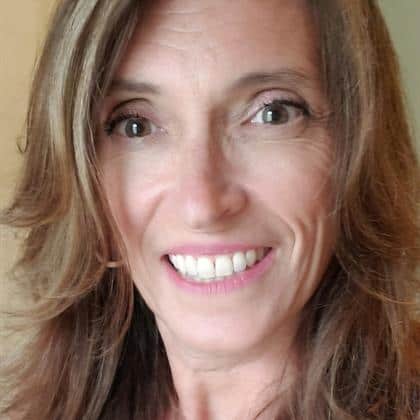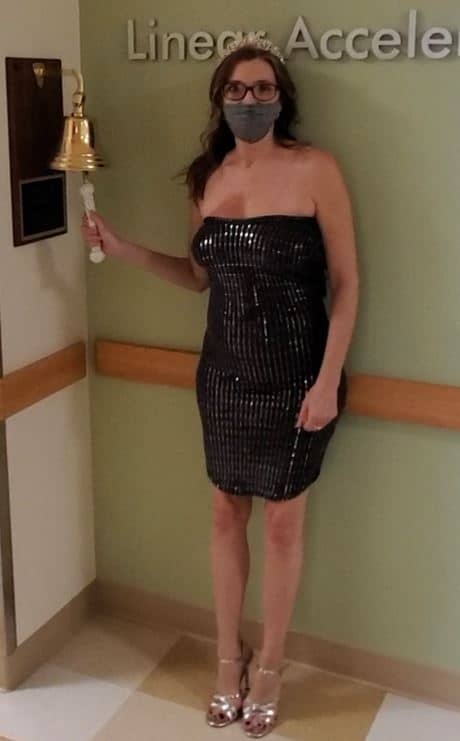
In March 2020, Kim Uradnik went in for her annual mammogram. Her doctor also requested an ultrasound. “There was a spot she said we’d keep an eye on. She thought it was calcification,” Kim said. “She told me it was nothing to worry about, but to come back in September.”
Six months later, Kim had another ultrasound and mammogram. “I was sitting in the exam room afterward and the doctor walked in. As soon as I saw her, I knew something was off,” Kim recalled. “She said the calcifications had expanded and they wanted to look over my past year’s mammogram. My heart started racing at that point. Why did we need to compare the two? What was the doctor not telling me?”
A week later, Kim’s doctor called and requested she come in for a biopsy. “She said ‘let’s not panic yet, this isn’t a death sentence, we just need to figure out what this is, because we don’t know yet,’” Kim said. “She told me to take a breath, to go one step at a time, not jump five steps ahead.”
The biopsy results showed Kim had stage 0, ductal carcinoma in situ. She would need surgery and radiation therapy. “Nothing made sense. I had no idea what any of this meant. I didn’t know if I was dying. Everything happened so fast,” she said. “But it was stage 0. It was very treatable.”
Kim’s thoughts immediately turned to her children. “How was I going to tell my kids? I called them and we sat down together and told them what was going on. They were all supportive, of course, they said we’ll figure it out. We’re going to go one step at a time. Breathe. One step at a time.”
The next day was a blur. The surgeon’s office called and asked if Kim could come in the next day. They’d had a cancellation. It was in the midst of COVID-19 and not knowing how soon another slot would open up, Kim said yes. “I thought, my God, everyone is moving so fast. I was still trying to process, to figure out where my notes were,” said Kim.
Kim was able to bring a friend with her to the meeting with the surgeon. “I’m so glad she was there, because there was so much information – mastectomy or lumpectomy, reconstruction, plastic surgeons, medications, radiation, genetic testing,” she said. “I came home with a three-ring binder with all of this information. It was the most bizarre, chaotic experience.”
Over the next couple of weeks, Kim, her kids and her siblings chatted over Zoom and in text messages, going through her options. “I needed their input. I had no bandwidth. I couldn’t concentrate,” she said. Kim’s surgery was scheduled for Friday, November 13. “I’d never had surgery in my life. No one could go with me because of COVID. I had a lot of anxiety about surgery, and then I had to leave everyone and go alone,” she said.
Kim had a lumpectomy, after learning from genetic testing that she did not have an inherited genetic mutation. Once she recovered from surgery, Kim had 20 sessions of radiation therapy. “I made radiation a fun thing,” she said. “I’m a shoe person, so I decided if I’m going to kick this invisible beast’s ass, then I was going to show up like I was kicking ass.” She wore a different pair of high heels every day of radiation, which took place during a Connecticut winter. On her last day of radiation, she showed up in a sequined dress, silver heels and a tiara.

During treatment, Kim realized that, compared to many of the women she met, her journey was relatively easy. “Some of these women had it much worse, and their tenacity and strength and outlook were just amazing,” she said. “And that’s what brought me around to becoming a Susan G. Komen advocate.”
While Kim didn’t have any issues with insurance – she was in between jobs and on her state Medicaid plan at the time – she met women in treatment who were struggling. “Our system is broken. It makes me so mad to see some of the hoops people had to jump through, just to get treatment. I decided I’ll do this, I’ll come in and fight for others,” she said. “I’ll knock on every Congress and Senate person’s door if I must. You shouldn’t have to think, do I put food on the table or take a pill? Do I pay the mortgage or the light bill or do I take lifesaving treatment?”
Kim is passionate about the work she does on behalf of Komen to make an impact in the fight against breast cancer, and has advice for others, whether they’ve been affected by breast cancer or not. “Educate yourself. Learn about the systems that are broken. Do research,” she said. “Then start speaking out, talk to anyone who will listen, put it on social media, make it known what’s happening. Just because I’m done with treatment doesn’t mean breast cancer goes away. We need to be out there advocating for everyone. We don’t have a choice.”
You can learn more about getting involved here.
Statements and opinions expressed are that of the individual and do not express the views or opinions of Susan G. Komen. This information is being provided for educational purposes only and is not to be construed as medical advice. Persons with breast cancer should consult their healthcare provider with specific questions or concerns about their treatment.



